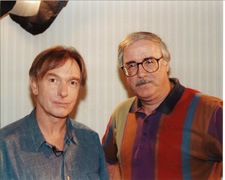Professor writes two books on film industry innovators
LAWRENCE – In two separate books, John Tibbetts, associate professor of film and media studies at the University of Kansas, examines the careers of two visionary filmmakers who preside over the birth of a new era of cinema in their countries.
 In “Peter Weir Interviews,” Tibbetts studies the Australian who helped usher in a new generation of filmmakers and put the country's cinema on the map with such films as “Picnic at Hanging Rock” and “Gallipoli.” Later, Weir’s success in Hollywood – including Academy Award nominations for “Witness,” “Dead Poets Society,” “Green Card,” “The Truman Show” and “Master and Commander” – heralded the arrival of other Australian filmmakers to the American film industry.
In “Peter Weir Interviews,” Tibbetts studies the Australian who helped usher in a new generation of filmmakers and put the country's cinema on the map with such films as “Picnic at Hanging Rock” and “Gallipoli.” Later, Weir’s success in Hollywood – including Academy Award nominations for “Witness,” “Dead Poets Society,” “Green Card,” “The Truman Show” and “Master and Commander” – heralded the arrival of other Australian filmmakers to the American film industry.
 In “Douglas Fairbanks and the American Century,” Tibbetts and co-author James M. Welsh write about the silent film star who shaped much of Hollywood in the early part of the 20th century. Fairbanks, known for his boyish charm and dashing good looks, established Hollywood aristocracy, made the first feature comedies in the United States, took filmgoers abroad in swashbuckling adventures, produced one of the first Technicolor films in 1926, co-founded United Artists studio and was the first president of the Academy of Motion Pictures. Fairbanks was the inspiration for Jean Dujardin’s 2011 Oscar-winning performance in “The Artist.”
In “Douglas Fairbanks and the American Century,” Tibbetts and co-author James M. Welsh write about the silent film star who shaped much of Hollywood in the early part of the 20th century. Fairbanks, known for his boyish charm and dashing good looks, established Hollywood aristocracy, made the first feature comedies in the United States, took filmgoers abroad in swashbuckling adventures, produced one of the first Technicolor films in 1926, co-founded United Artists studio and was the first president of the Academy of Motion Pictures. Fairbanks was the inspiration for Jean Dujardin’s 2011 Oscar-winning performance in “The Artist.”
 To Tibbetts, both men celebrated youth. Fairbanks was the eternal child, a combination of Puck, Peter Pan and the go-getting young American. Weir’s movies centered on youthful ideals and the turmoil that disturbs those ideals.
To Tibbetts, both men celebrated youth. Fairbanks was the eternal child, a combination of Puck, Peter Pan and the go-getting young American. Weir’s movies centered on youthful ideals and the turmoil that disturbs those ideals.
“The everyday world was never enough for either of them,” Tibbetts said. “They both made movies about things that weren’t immediately apparent in our more prosaic world.”
Tibbetts has been fascinated with both film icons for decades. In 1977, Tibbetts and Welsh released their first book on Fairbanks, “His Majesty the American: The Cinema of Douglas Fairbanks, Sr.” It was the first book to focus on Fairbanks’ early films. In the newly released book, interviews and essays offer fresh perspectives on the film legend’s life and work. Also included is the account of a French art director on the set of Fairbanks’ last silent film, “The Iron Mask.”
“It’s a day-by-day, week-by-week account of what it was like to work on a silent film set,” Tibbetts said. “He marvels with almost childlike eyes at this fabled community making movies. For the scholar, this is a crucial on-site look at United Artists studios and the making of these films.”
Tibbetts first interviewed Weir in 1993, shortly after the making of “Fearless.” Over the years, Tibbetts interviewed him several more times, even traveling to Australia to visit Weir in his native city of Sydney. The book includes Tibbetts’ interview with Russell Boyd, the cinematographer on many of Weir’s films, and interviews with Weir from other writers that date back to the 1970s.
Also included in the book is a never-before published lecture Weir gave in Washington, D.C., connected to Anzac Day, a national day of remembrance in Australia and New Zealand, in which he shares his reaction to visiting the trenches of Gallipoli.
“It’s very moving. And when you read it, you want to see the film 'Gallipoli' all over again,” Tibbetts said.
Another commonality is that both men leave unanswered questions in the public imagination.
In the case of Fairbanks, the world has wondered why the greatest star of the silent film era didn’t find equal success in the years that followed the introduction of the “talkies.” Tibbetts argues that while Fairbanks' work varied wildly in the years after silent films, it included some of his best work, including his final film in 1934, “The Private Life of Don Juan.”
“He grew up, he grew old, and as a result he grew restless,” Tibbetts said. “But as a result of that restlessness and the deepening depression about his career being behind him came some of his best work.”
Much of that work has been overlooked, Tibbetts said.
For Weir, questions turn to the mysterious ending of one of his best-known early films, “Picnic at Hanging Rock,” which never fully reveals why a group of Australian schoolgirls disappear. Was it flying saucers? An earthquake? The audience is never told.
“Weir is nothing if not ambivalent. It’s typical of all of Weir’s films,” Tibbetts said. “Ambiguity is everywhere. He embraces it and invites his viewers to do the same.”
During one of his interviews with Weir, Tibbetts asked whether he enjoyed leaving the audience in such confusion.
Weir told him, “No, I’ve probably got my fingers firmly on my brow, thinking, ‘Is this the right ending?'”
The University Press of Mississippi published both books.